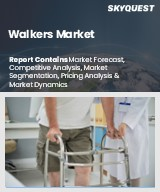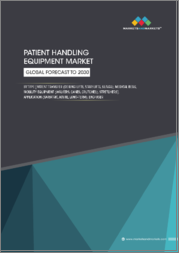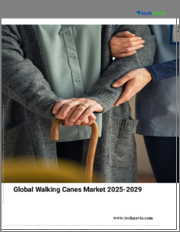
|
시장보고서
상품코드
1599364
보행 보조기 시장 : 유형별, 최종사용자별 - 세계 예측(2025-2030년)Walking Aids Market by Type (Cane, Crutch, Rollator), End-User (Disabled Person, Elderly) - Global Forecast 2025-2030 |
||||||
2023년 보행 보조기 시장 규모는 26억 9,000만 달러로 2024년에는 29억 달러에 달할 것으로 예상되며, CAGR 7.95%로 성장하여 2030년에는 46억 달러에 달할 것으로 예상됩니다.
보행 보조기 시장은 현재 고령화, 이동 관련 장애 유병률 증가, 보조 기술 발전 등 복합적인 요인에 의해 주도되고 있습니다. 보행 보조기는 지팡이, 목발, 보행기 등 일시적 또는 영구적인 운동 장애를 가진 사람들의 이동과 자립을 강화하기 위한 필요성에 부응합니다. 의료 시설, 재활센터, 노인 및 수술, 부상, 이동에 영향을 미치는 질병에서 회복한 사람들이 개인적으로 사용하는 등 다양한 용도로 사용됩니다. 주요 성장 요인으로는 경량화, 내구성 향상, 사용하기 쉬운 디자인으로 이어지는 기술 발전, 물리치료 및 재활에 대한 인식 증가 등이 있습니다. 이 시장의 잠재적인 비즈니스 기회는 사용자의 활동과 건강을 모니터링하는 센서가 장착된 개인화된 스마트 보행 보조기와 고령화가 점점 더 가속화되고 있는 신흥 시장 진출에 있습니다. 그럼에도 불구하고 첨단 보행 보조기의 높은 가격, 제한적인 보상 정책, 보조기구 사용과 관련된 사용자의 불편함과 낙인감으로 인한 불일치한 순응도가 시장 성장을 저해하는 요인입니다. 이러한 성장세를 활용하기 위해서는 보다 비용 효율적이고 편안한 제품을 만들기 위한 재료 과학의 지속적인 혁신이 필수적입니다. 또한, 디지털 헬스 기술의 통합은 원격 모니터링 및 보조의 길을 열어줄 수 있습니다. 인체공학적으로 설계된 보조기구와 사용자별 맞춤화에 대한 연구와 같은 새로운 트렌드는 유망한 혁신의 길을 제시합니다. 조직은 유통과 접근성을 강화하기 위해 소비자 교육 및 의료 서비스 제공업체와의 파트너십 확대에 집중해야 합니다. 보행 보조기 시장은 역동적이고 진화하는 특성을 보이며, 스마트 기술과 지속가능한 재료의 연구 및 개발에 큰 잠재력을 가지고 있습니다. 시장 입지를 유지하고 확장을 촉진하기 위해서는 경쟁력 있는 가격 책정과 이 분야에 대한 전략적 투자가 권장됩니다.
| 주요 시장 통계 | |
|---|---|
| 기준 연도(2023년) | 26억 9,000만 달러 |
| 예측 연도(2024년) | 29억 달러 |
| 예측 연도(2030년) | 46억 달러 |
| CAGR(%) | 7.95% |
시장 역학 : 빠르게 진화하는 보행 보조기 시장의 주요 시장 인사이트 공개
보행 보조기 시장은 수요 및 공급의 역동적인 상호작용을 통해 변화하고 있습니다. 이러한 시장 역학의 변화를 이해함으로써 기업은 정보에 입각한 투자 결정을 내리고, 전략적인 의사결정을 정교화하며, 새로운 비즈니스 기회를 포착할 수 있습니다. 이러한 트렌드를 종합적으로 파악함으로써 기업은 정치적, 지리적, 기술적, 사회적, 경제적 영역 전반에 걸친 다양한 리스크를 줄일 수 있으며, 소비자 행동과 그것이 제조 비용 및 구매 동향에 미치는 영향을 보다 명확하게 이해할 수 있습니다.
- 시장 성장 촉진요인
- 노인 인구 증가 및 비만 인구 증가
- 관절염과 파킨슨병의 발병률 증가
- 우호적인 정부 정책 및 방침
- 시장 성장 억제요인
- 높은 제품 비용
- 시장 기회
- 보행 보조기 맞춤화를 통한 견고한 기술 발전
- 제품 개선을 위한 새로운 연구 개발 활동
- 시장 과제
- 시장에서의 저품질 제품의 가용성
Porter's Five Forces : 보행 보조기 시장 공략을 위한 전략 도구
Porter's Five Forces 프레임워크는 시장 상황의 경쟁 구도를 이해하는 중요한 도구입니다. Porter's Five Forces 프레임워크는 기업의 경쟁력을 평가하고 전략적 기회를 탐색할 수 있는 명확한 방법을 제공합니다. 이 프레임워크는 기업이 시장 내 세력도를 평가하고 신규 사업의 수익성을 판단하는 데 도움이 됩니다. 이러한 인사이트를 통해 기업은 강점을 활용하고 약점을 보완하며 잠재적인 도전을 피함으로써 보다 강력한 시장 포지셔닝을 확보할 수 있습니다.
PESTLE 분석 : 보행보조기 시장의 외부 영향 파악
외부 거시 환경 요인은 보행 보조기 시장의 성과 역학을 형성하는 데 매우 중요한 역할을 합니다. 정치적, 경제적, 사회적, 기술적, 법적, 환경적 요인에 대한 분석은 이러한 영향을 탐색하는 데 필요한 정보를 제공하며, PESTLE 요인을 조사함으로써 기업은 잠재적 위험과 기회를 더 잘 이해할 수 있습니다. 이러한 분석을 통해 기업은 규제, 소비자 선호도, 경제 동향의 변화를 예측하고 선제적이고 능동적인 의사결정을 내릴 준비를 할 수 있습니다.
시장 점유율 분석 : 보행보조기 시장 경쟁 상황 파악
보행 보조기 시장의 상세한 시장 점유율 분석을 통해 공급업체의 성과를 종합적으로 평가할 수 있습니다. 기업은 수익, 고객 기반, 성장률과 같은 주요 지표를 비교하여 경쟁적 위치를 파악할 수 있습니다. 이 분석은 시장의 집중화, 단편화, 통합의 추세를 파악할 수 있으며, 공급업체는 치열한 경쟁 속에서 자신의 입지를 강화할 수 있는 전략적 의사결정을 내리는 데 필요한 인사이트를 얻을 수 있습니다.
FPNV 포지셔닝 매트릭스 : 보행 보조기 시장에서의 업체 성과 평가
FPNV 포지셔닝 매트릭스는 보행 보조기 시장에서 공급업체를 평가하는 중요한 도구입니다. 이 매트릭스를 통해 비즈니스 조직은 벤더의 비즈니스 전략과 제품 만족도를 기반으로 평가하여 목표에 부합하는 정보에 입각한 의사결정을 내릴 수 있으며, 4개의 사분면으로 벤더를 명확하고 정확하게 세분화하여 전략 목표에 가장 적합한 파트너와 솔루션을 식별할 수 있습니다. 전략 목표에 가장 적합한 파트너와 솔루션을 식별할 수 있습니다.
전략 분석 및 추천 : 보행 보조기 시장에서의 성공을 위한 전략 분석과 성공의 길을 그립니다.
보행 보조기 시장 전략 분석은 세계 시장에서 입지를 강화하고자 하는 기업에게 필수적입니다. 주요 자원, 역량 및 성과 지표를 검토함으로써 기업은 성장 기회를 식별하고 개선할 수 있습니다. 이러한 접근 방식을 통해 경쟁 환경의 도전을 극복하고 새로운 비즈니스 기회를 활용하여 장기적인 성공을 거둘 수 있도록 준비할 수 있습니다.
이 보고서는 주요 관심 분야를 포괄하는 시장에 대한 종합적인 분석을 제공합니다.
1. 시장 침투도 : 현재 시장 환경의 상세한 검토, 주요 기업의 광범위한 데이터, 시장 도달 범위 및 전반적인 영향력 평가.
2. 시장 개척도 : 신흥 시장에서의 성장 기회를 파악하고, 기존 분야의 확장 가능성을 평가하며, 미래 성장을 위한 전략적 로드맵을 제공합니다.
3. 시장 다각화 : 최근 제품 출시, 미개척 지역, 업계의 주요 발전, 시장을 형성하는 전략적 투자를 분석합니다.
4. 경쟁 평가 및 정보 : 경쟁 구도를 철저히 분석하여 시장 점유율, 사업 전략, 제품 포트폴리오, 인증, 규제 당국의 승인, 특허 동향, 주요 기업의 기술 발전 등을 검토합니다.
5. 제품 개발 및 혁신 : 향후 시장 성장을 가속할 것으로 예상되는 첨단 기술, 연구 개발 활동 및 제품 혁신을 강조합니다.
이해관계자들이 충분한 정보를 바탕으로 의사결정을 내릴 수 있도록 다음과 같은 중요한 질문에 대한 답변도 제공합니다.
1. 현재 시장 규모와 향후 성장 전망은?
2. 최고의 투자 기회를 제공하는 제품, 부문, 지역은?
3. 시장을 형성하는 주요 기술 동향과 규제의 영향은?
4. 주요 벤더 시장 점유율과 경쟁 포지션은?
5. 벤더 시장 진입 및 철수 전략의 원동력이 되는 수익원과 전략적 기회는 무엇인가?
목차
제1장 서문
제2장 조사 방법
제3장 주요 요약
제4장 시장 개요
제5장 시장 인사이트
- 시장 역학
- 성장 촉진요인
- 성장 억제요인
- 기회
- 과제
- 시장 세분화 분석
- Porter's Five Forces 분석
- PESTEL 분석
- 정치
- 경제
- 사회
- 기술
- 법률
- 환경
제6장 보행 보조기 시장 : 유형별
- 지팡이
- 다리가 여러 개인 지팡이
- 단일 지팡이
- 목발
- 겨드랑이 또는 겨드랑 밑 목발
- 팔뚝용 목발
- 거터 목발
- 보행기
- 워커
제7장 보행 보조기 시장 : 최종사용자별
- 장애인
- 노인
제8장 아메리카의 보행 보조기 시장
- 아르헨티나
- 브라질
- 캐나다
- 멕시코
- 미국
제9장 아시아태평양의 보행 보조기 시장
- 호주
- 중국
- 인도
- 인도네시아
- 일본
- 말레이시아
- 필리핀
- 싱가포르
- 한국
- 대만
- 태국
- 베트남
제10장 유럽, 중동 및 아프리카의 보행 보조기 시장
- 덴마크
- 이집트
- 핀란드
- 프랑스
- 독일
- 이스라엘
- 이탈리아
- 네덜란드
- 나이지리아
- 노르웨이
- 폴란드
- 카타르
- 러시아
- 사우디아라비아
- 남아프리카공화국
- 스페인
- 스웨덴
- 스위스
- 터키
- 아랍에미리트
- 영국
제11장 경쟁 상황
- 시장 점유율 분석 2023
- FPNV 포지셔닝 매트릭스, 2023
- 경쟁 시나리오 분석
- 전략 분석과 제안
기업 리스트
- 21st century scientific Inc
- Amigo Mobility International Inc.
- Benmor Medical
- Briggs Healthcare
- Eurovema Mobility AB
- Evolution Technologies Inc.
- GF Health Products, Inc.
- HUMAN CARE GROUP
- Invacare Corporation
- Karman Healthcare Inc
- MATSUNAGA MANUFACTORY Co., Ltd.
- Medical Depot, Inc.
- Otto Bock Australia Pty. Ltd.
- Patterson Medical Holdings Inc.
- Pride mobility products corp
- Stryker Corporation
- Sunrise Medical, Inc.
- Topro Industrie AS
The Walking Aids Market was valued at USD 2.69 billion in 2023, expected to reach USD 2.90 billion in 2024, and is projected to grow at a CAGR of 7.95%, to USD 4.60 billion by 2030.
The walking aids market is currently driven by a complex interplay of factors concerning the aging population, increasing prevalence of mobility-related disorders, and advancements in assistive technology. Walking aids, encompassing devices like canes, crutches, and walkers, serve the necessity of enhancing mobility and independence for individuals with temporary or permanent mobility impairments. The application extends across healthcare facilities, rehabilitation centers, and individual use by the elderly or those recovering from surgeries, injuries, or medical conditions affecting their mobility. Key growth influencers include technological advancements, which have led to lighter, more durable, and user-friendly designs, and the rising awareness around physical therapy and rehabilitation. Potential opportunities within the market lie in personalized, smart walking aids equipped with sensors to monitor user activity and health, as well as expanding into emerging markets where aging demographics are becoming increasingly significant. Nevertheless, the market growth is hindered by challenges such as high costs of advanced walking aids, limited reimbursement policies, and the variability in adherence due to user discomfort or stigma associated with aid usage. To capitalize on growth, continuous innovation in material science to create more cost-effective and comfortable products is essential. Moreover, integrating digital health technologies could open pathways in remote monitoring and assistance. Emerging trends like ergonomically designed aids and research into user-specific customization reveal promising innovation avenues. Organizations should focus on consumer education and expanded partnerships with healthcare providers to enhance distribution and accessibility. The walking aids market demonstrates a dynamic and evolving nature, with significant potential for R&D in smart technologies and sustainable materials. As such, strategic investments in these areas, combined with competitive pricing, are recommended to sustain market presence and drive expansion.
| KEY MARKET STATISTICS | |
|---|---|
| Base Year [2023] | USD 2.69 billion |
| Estimated Year [2024] | USD 2.90 billion |
| Forecast Year [2030] | USD 4.60 billion |
| CAGR (%) | 7.95% |
Market Dynamics: Unveiling Key Market Insights in the Rapidly Evolving Walking Aids Market
The Walking Aids Market is undergoing transformative changes driven by a dynamic interplay of supply and demand factors. Understanding these evolving market dynamics prepares business organizations to make informed investment decisions, refine strategic decisions, and seize new opportunities. By gaining a comprehensive view of these trends, business organizations can mitigate various risks across political, geographic, technical, social, and economic domains while also gaining a clearer understanding of consumer behavior and its impact on manufacturing costs and purchasing trends.
- Market Drivers
- Increasing elderly population and rise in obesity among population
- Rising incidence of arthritis and Parkinson's disease
- Favorable government policies and regulations
- Market Restraints
- High cost of the product
- Market Opportunities
- Robust technological advancements with customization of walking aids
- Emerging research and development activities to improvise the product
- Market Challenges
- Availability of low quality products in the market
Porter's Five Forces: A Strategic Tool for Navigating the Walking Aids Market
Porter's five forces framework is a critical tool for understanding the competitive landscape of the Walking Aids Market. It offers business organizations with a clear methodology for evaluating their competitive positioning and exploring strategic opportunities. This framework helps businesses assess the power dynamics within the market and determine the profitability of new ventures. With these insights, business organizations can leverage their strengths, address weaknesses, and avoid potential challenges, ensuring a more resilient market positioning.
PESTLE Analysis: Navigating External Influences in the Walking Aids Market
External macro-environmental factors play a pivotal role in shaping the performance dynamics of the Walking Aids Market. Political, Economic, Social, Technological, Legal, and Environmental factors analysis provides the necessary information to navigate these influences. By examining PESTLE factors, businesses can better understand potential risks and opportunities. This analysis enables business organizations to anticipate changes in regulations, consumer preferences, and economic trends, ensuring they are prepared to make proactive, forward-thinking decisions.
Market Share Analysis: Understanding the Competitive Landscape in the Walking Aids Market
A detailed market share analysis in the Walking Aids Market provides a comprehensive assessment of vendors' performance. Companies can identify their competitive positioning by comparing key metrics, including revenue, customer base, and growth rates. This analysis highlights market concentration, fragmentation, and trends in consolidation, offering vendors the insights required to make strategic decisions that enhance their position in an increasingly competitive landscape.
FPNV Positioning Matrix: Evaluating Vendors' Performance in the Walking Aids Market
The Forefront, Pathfinder, Niche, Vital (FPNV) Positioning Matrix is a critical tool for evaluating vendors within the Walking Aids Market. This matrix enables business organizations to make well-informed decisions that align with their goals by assessing vendors based on their business strategy and product satisfaction. The four quadrants provide a clear and precise segmentation of vendors, helping users identify the right partners and solutions that best fit their strategic objectives.
Strategy Analysis & Recommendation: Charting a Path to Success in the Walking Aids Market
A strategic analysis of the Walking Aids Market is essential for businesses looking to strengthen their global market presence. By reviewing key resources, capabilities, and performance indicators, business organizations can identify growth opportunities and work toward improvement. This approach helps businesses navigate challenges in the competitive landscape and ensures they are well-positioned to capitalize on newer opportunities and drive long-term success.
Key Company Profiles
The report delves into recent significant developments in the Walking Aids Market, highlighting leading vendors and their innovative profiles. These include 21st century scientific Inc, Amigo Mobility International Inc., Benmor Medical, Briggs Healthcare, Eurovema Mobility AB, Evolution Technologies Inc., GF Health Products, Inc., HUMAN CARE GROUP, Invacare Corporation, Karman Healthcare Inc, MATSUNAGA MANUFACTORY Co., Ltd., Medical Depot, Inc., Otto Bock Australia Pty. Ltd., Patterson Medical Holdings Inc., Pride mobility products corp, Stryker Corporation, Sunrise Medical, Inc., and Topro Industrie AS.
Market Segmentation & Coverage
This research report categorizes the Walking Aids Market to forecast the revenues and analyze trends in each of the following sub-markets:
- Based on Type, market is studied across Cane, Crutch, Rollator, and Walker. The Cane is further studied across Multiple-Legged Cane and Single Cane. The Crutch is further studied across Axilla or Underarm Crutch, Forearm Crutch, and Gutter Crutch.
- Based on End-User, market is studied across Disabled Person and Elderly.
- Based on Region, market is studied across Americas, Asia-Pacific, and Europe, Middle East & Africa. The Americas is further studied across Argentina, Brazil, Canada, Mexico, and United States. The United States is further studied across California, Florida, Illinois, New York, Ohio, Pennsylvania, and Texas. The Asia-Pacific is further studied across Australia, China, India, Indonesia, Japan, Malaysia, Philippines, Singapore, South Korea, Taiwan, Thailand, and Vietnam. The Europe, Middle East & Africa is further studied across Denmark, Egypt, Finland, France, Germany, Israel, Italy, Netherlands, Nigeria, Norway, Poland, Qatar, Russia, Saudi Arabia, South Africa, Spain, Sweden, Switzerland, Turkey, United Arab Emirates, and United Kingdom.
The report offers a comprehensive analysis of the market, covering key focus areas:
1. Market Penetration: A detailed review of the current market environment, including extensive data from top industry players, evaluating their market reach and overall influence.
2. Market Development: Identifies growth opportunities in emerging markets and assesses expansion potential in established sectors, providing a strategic roadmap for future growth.
3. Market Diversification: Analyzes recent product launches, untapped geographic regions, major industry advancements, and strategic investments reshaping the market.
4. Competitive Assessment & Intelligence: Provides a thorough analysis of the competitive landscape, examining market share, business strategies, product portfolios, certifications, regulatory approvals, patent trends, and technological advancements of key players.
5. Product Development & Innovation: Highlights cutting-edge technologies, R&D activities, and product innovations expected to drive future market growth.
The report also answers critical questions to aid stakeholders in making informed decisions:
1. What is the current market size, and what is the forecasted growth?
2. Which products, segments, and regions offer the best investment opportunities?
3. What are the key technology trends and regulatory influences shaping the market?
4. How do leading vendors rank in terms of market share and competitive positioning?
5. What revenue sources and strategic opportunities drive vendors' market entry or exit strategies?
Table of Contents
1. Preface
- 1.1. Objectives of the Study
- 1.2. Market Segmentation & Coverage
- 1.3. Years Considered for the Study
- 1.4. Currency & Pricing
- 1.5. Language
- 1.6. Stakeholders
2. Research Methodology
- 2.1. Define: Research Objective
- 2.2. Determine: Research Design
- 2.3. Prepare: Research Instrument
- 2.4. Collect: Data Source
- 2.5. Analyze: Data Interpretation
- 2.6. Formulate: Data Verification
- 2.7. Publish: Research Report
- 2.8. Repeat: Report Update
3. Executive Summary
4. Market Overview
5. Market Insights
- 5.1. Market Dynamics
- 5.1.1. Drivers
- 5.1.1.1. Increasing elderly population and rise in obesity among population
- 5.1.1.2. Rising incidence of arthritis and Parkinson's disease
- 5.1.1.3. Favorable government policies and regulations
- 5.1.2. Restraints
- 5.1.2.1. High cost of the product
- 5.1.3. Opportunities
- 5.1.3.1. Robust technological advancements with customization of walking aids
- 5.1.3.2. Emerging research and development activities to improvise the product
- 5.1.4. Challenges
- 5.1.4.1. Availability of low quality products in the market
- 5.1.1. Drivers
- 5.2. Market Segmentation Analysis
- 5.3. Porter's Five Forces Analysis
- 5.3.1. Threat of New Entrants
- 5.3.2. Threat of Substitutes
- 5.3.3. Bargaining Power of Customers
- 5.3.4. Bargaining Power of Suppliers
- 5.3.5. Industry Rivalry
- 5.4. PESTLE Analysis
- 5.4.1. Political
- 5.4.2. Economic
- 5.4.3. Social
- 5.4.4. Technological
- 5.4.5. Legal
- 5.4.6. Environmental
6. Walking Aids Market, by Type
- 6.1. Introduction
- 6.2. Cane
- 6.2.1. Multiple-Legged Cane
- 6.2.2. Single Cane
- 6.3. Crutch
- 6.3.1. Axilla or Underarm Crutch
- 6.3.2. Forearm Crutch
- 6.3.3. Gutter Crutch
- 6.4. Rollator
- 6.5. Walker
7. Walking Aids Market, by End-User
- 7.1. Introduction
- 7.2. Disabled Person
- 7.3. Elderly
8. Americas Walking Aids Market
- 8.1. Introduction
- 8.2. Argentina
- 8.3. Brazil
- 8.4. Canada
- 8.5. Mexico
- 8.6. United States
9. Asia-Pacific Walking Aids Market
- 9.1. Introduction
- 9.2. Australia
- 9.3. China
- 9.4. India
- 9.5. Indonesia
- 9.6. Japan
- 9.7. Malaysia
- 9.8. Philippines
- 9.9. Singapore
- 9.10. South Korea
- 9.11. Taiwan
- 9.12. Thailand
- 9.13. Vietnam
10. Europe, Middle East & Africa Walking Aids Market
- 10.1. Introduction
- 10.2. Denmark
- 10.3. Egypt
- 10.4. Finland
- 10.5. France
- 10.6. Germany
- 10.7. Israel
- 10.8. Italy
- 10.9. Netherlands
- 10.10. Nigeria
- 10.11. Norway
- 10.12. Poland
- 10.13. Qatar
- 10.14. Russia
- 10.15. Saudi Arabia
- 10.16. South Africa
- 10.17. Spain
- 10.18. Sweden
- 10.19. Switzerland
- 10.20. Turkey
- 10.21. United Arab Emirates
- 10.22. United Kingdom
11. Competitive Landscape
- 11.1. Market Share Analysis, 2023
- 11.2. FPNV Positioning Matrix, 2023
- 11.3. Competitive Scenario Analysis
- 11.4. Strategy Analysis & Recommendation
Companies Mentioned
- 1. 21st century scientific Inc
- 2. Amigo Mobility International Inc.
- 3. Benmor Medical
- 4. Briggs Healthcare
- 5. Eurovema Mobility AB
- 6. Evolution Technologies Inc.
- 7. GF Health Products, Inc.
- 8. HUMAN CARE GROUP
- 9. Invacare Corporation
- 10. Karman Healthcare Inc
- 11. MATSUNAGA MANUFACTORY Co., Ltd.
- 12. Medical Depot, Inc.
- 13. Otto Bock Australia Pty. Ltd.
- 14. Patterson Medical Holdings Inc.
- 15. Pride mobility products corp
- 16. Stryker Corporation
- 17. Sunrise Medical, Inc.
- 18. Topro Industrie AS



















